
Ahmedabad is the most populous city in the Indian state of Gujarat. It is the administrative headquarters of the Ahmedabad district and the seat of the Gujarat High Court. Ahmedabad's population of 5,570,585 makes it the fifth-most populous city in India, and the encompassing urban agglomeration population estimated at 6,357,693 is the seventh-most populous in India. Ahmedabad is located near the banks of the Sabarmati River, 25 km (16 mi) from the capital of Gujarat, Gandhinagar, also known as its twin city.
This page provides a historical timeline of Ahmedabad, the sixth largest city in India.

Mehsana, also spelled Mahesana, is a city and the headquarters of Mehsana district in the Indian state of Gujarat. Established in 14th century, the city was under Gaekwads of Baroda State from 18th century to the independence of India in 1947. Dairy, oil and natural gas are major industries in the city.
Maninagar is an area of Ahmedabad city, Gujarat, India. It is located in the southern part of the city and an important area of the city. It can be divided into two regions - Maninagar East and Maninagar West, separated by the Maninagar Railway Station.

Ahmedabad district or Amdavad district, is a district comprises the city of Amdavad, in the central part of the state of Gujarat in western India. It is the seventh most populous district in India.

Indo-Islamic architecture is the architecture of the Indian subcontinent produced by and for Islamic patrons and purposes. Despite an initial Arab presence in Sindh, the development of Indo-Islamic architecture began in earnest with the establishment of Delhi as the capital of the Ghurid dynasty in 1193. Succeeding the Ghurids was the Delhi Sultanate, a series of Central Asian dynasties that consolidated much of North India, and later the Mughal Empire by the 15th century. Both of these dynasties introduced Islamic architecture and art styles from West Asia into the Indian subcontinent.

The Moti Shahi Mahal is a palace built by the Mughal emperor Shahjahan between 1616 and 1623, when he was still a prince. It now hosts the Sardar Vallabhbhai Patel National Memorial, which is a museum and exhibition centre dedicated to Vallabhbhai Patel located in Shahibaug, Ahmedabad, Gujarat, near Civil Hospital, Ahmedabad. It is surrounded by well laid gardens.
Ahmedabad is the largest city in the state of Gujarat. It is located in western India on the banks of the River Sabarmati. The city served as political as well as economical capital of the region since its establishment. The earliest settlement can be recorded around the 12th century under Chaulukya dynasty rule. The present city was founded on 26 February 1411 and announced as the capital on 4 March 1411 by Ahmed Shah I of Gujarat Sultanate as a new capital. Under the rule of sultanate (1411–1511) the city prospered followed by decline (1511–1572) when the capital was transferred to Champaner. For next 135 years (1572–1707), the city renewed greatness under the early rulers of Mughal Empire. The city suffered due to political instability (1707–1817) under late Mughal rulers followed by joint rule between Maratha and Mughal. The city further suffered following joint Maratha rule. The city again progressed when politically stabilized when British East India Company established the rule in the city (1818–1857). The city further renewed growth when it gain political freedom by establishment of municipality and opening of railway under British crown rule (1857–1947). Following arrival of Mahatma Gandhi in 1915, the city became centre stage of Indian independence movement. Many activists like Sardar Patel served the municipality of the city before taking part in the movement. After independence, the city was a part of Bombay state. When Gujarat was carved out in 1960, it again became the capital of the state until establishment of Gandhinagar in 1965. Ahmedabad is also the cultural and economical centre of Gujarat and the seventh largest city of India.
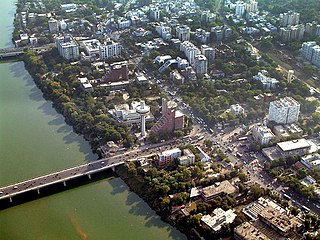
Ahmedabad is located on the banks of the River Sabarmati in the northern part of Gujarat and the western part of India. It is located at 23.03°N 72.58°E spanning an area of 205 km2. The average elevation is 53 metres.
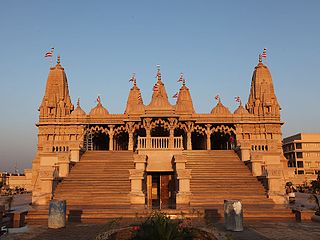
Mahuva is a town and taluka of Bhavnagar District, in the state of Gujarat, India. Located on the coast of the Arabian Sea, Mahuva is known for its mild weather and green, lush surroundings, including many coconut tree plantations. The town is a part of the Saurashtra region and is known as the Kashmir of Saurashtra. Mahuva is also known for wooden toys, raw onions, groundnuts, and a local variety of mango called the Jamadar. The region is home to a thriving agribusiness industry, particularly enterprises that dehydrate vegetables such as garlic and onions for use in processed foods.

Vastrapur Lake, officially Bhakta Kavi Narsinh Mehta Lake, is situated in western part of Ahmedabad in the Indian state of Gujarat. It is officially named after Narsinh Mehta.
Shahibaug is a locality of the city of Ahmedabad.

The mausoleum known as Hazira at Vadodara, Gujarat, India; contains the tombs of Qutb-ud-din Muhammad Khan who was the tutor of Salim, son and successor of Akbar, and also that of his son Naurang Khan who held important offices in Gujarat under Akbar. Qutb-ud-din was uncle of Mirza Aziz Koka, a foster brother of Akbar and the Governor of Gujarat thrice in between 1573 AD to 1583 AD. He was killed in 1583 by Muzaffar Shah III, the last sultan of Gujarat Sultanate.

Gujarat is a state along the western coast of India. Its coastline of about 1,600 km (990 mi) is the longest in the country, most of which lies on the Kathiawar peninsula. Gujarat is the fifth-largest Indian state by area, covering some 196,024 km2 (75,685 sq mi); and the ninth-most populous state, with a population of 60.4 million. It is a popular tourist destination in the country and was visited by 19.5 million domestic tourists and 210 thousand international tourists in 2020.
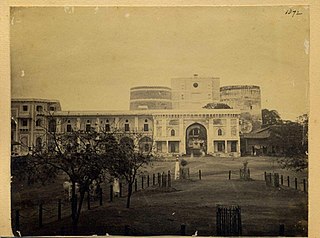
Bhadra Fort is situated in the walled city area of Ahmedabad, India. It was built by Ahmad Shah I in 1411. With its well carved royal palaces, mosques, gates and open spaces, it was renovated in 2014 by the Amdavad Municipal Corporation (AMC) and the Archaeological Survey of India (ASI) as a cultural centre for the city.

Chandola Lake is located near Dani Limda Road, Ahmedabad, Gujarat state, India and covers an area of 1200 hectares. It is a water reservoir, embanked and circular in form. It is also home for cormorants, painted storks and spoonbill birds. During the evening time, many people visit this place and take a leisure stroll.
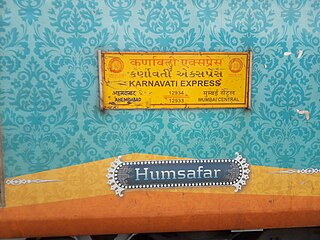
The 12933 / 12934 Karnavati Superfast Express is one of four express trains belonging to Indian Railways that offer Chair Car services between Ahmedabad Junction (ADI) and Mumbai Central (MMCT) in India. It operates as train number 12934 from Ahmedabad Junction to Mumbai Central and as train number 12933 in the reverse direction, serving the states of Maharashtra & Gujarat.
Reuben David was a zoologist and the founder of the Kankaria Zoo in Ahmedabad, Gujarat, India.

Gopi Talav or Gopi Lake is a lake in the Gopipura locality in the city of Surat in Gujarat state of India. It was built circa 1510 CE by Malik Gopi, who was an affluent merchant and governor of Surat during the Gujarat Sultanate. In 2012, the lake was renovated by Surat Municipal Corporation and the area surrounding redeveloped as a recreational facility.
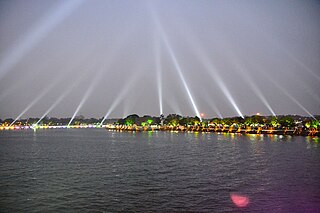
The Kankaria Carnival is an annual festival celebrated in Ahmedabad, Gujarat, India. Commencing in the last week of December, the carnival has been a significant part of Ahmedabad's cultural festivities since 2008. It features a broad spectrum of activities including cultural programs, art exhibitions, amusement rides, and social initiatives.



























